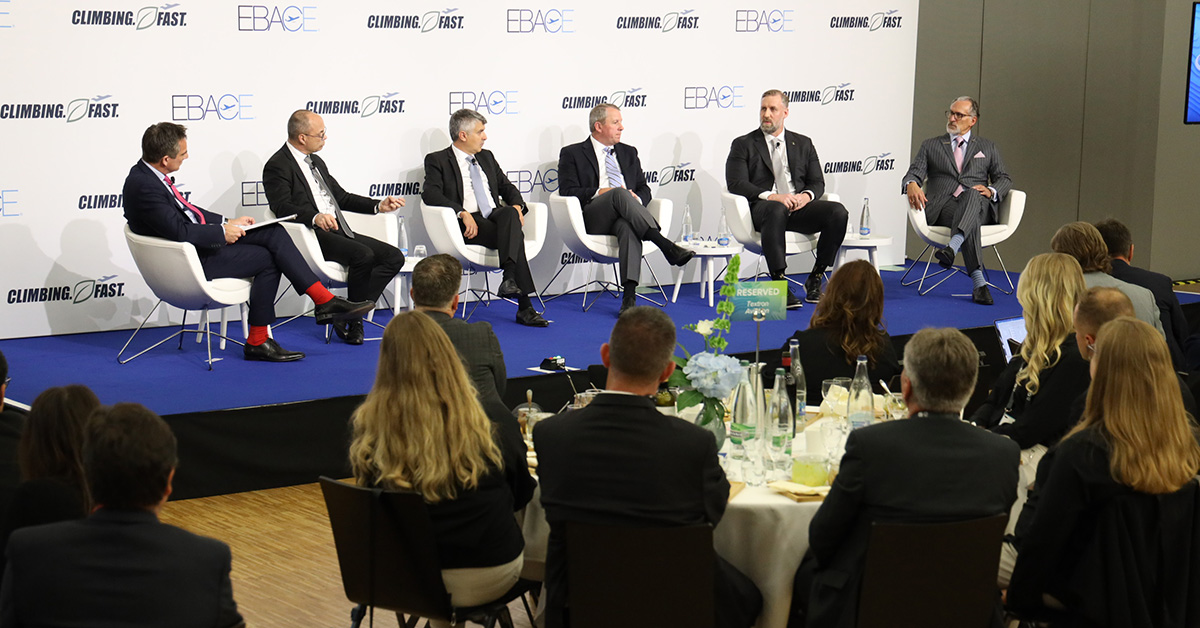EBACE2024 Newsmakers: Bizjet CEOs Point to Collaboration, Innovation, SAF as Keys to Reaching Net Zero
27 May 2024

Chief executives from many of the world’s top business jet manufacturers gathered at the 2024 European Business Aviation Convention & Exhibition (EBACE2024) in Geneva, Switzerland, to discuss what the future holds for their sector and what will be the keys to achieving net-zero emissions by 2050.
Moderated by broadcast journalist Jonathan Samuels, the 27 May Newsmakers Luncheon, titled “Aircraft CEOs Look to the Low-Emission Bizjets of the Future,” included leaders from Airbus Corporate Jets, Boeing Business Jets, Dassault Falcon Jet, Embraer Executive Jets and Textron Aviation.
The panelists said the most important tools to reaching net zero will be a mix of sustainable aviation fuel (SAF), new low-emissions propulsion systems, improved aircraft designs and manufacturing processes and most of all: collaboration.
“There’s not a single company that can take this challenge by itself,” said Chadi Saade, president, Airbus Corporate Jets. “So, it’s a question of collaboration; it’s a question of an ecosystem that we’re trying to build. As a catalyst for this ecosystem, working with partners from all around the industry, including airports, partners, energy producers, engine manufacturers and so on. We need this collaboration for the industry to work all together to reach this target.”
In addition to collaboration, the panel agreed that more emphasis needs to be put on producing and uploading SAF. In addition, they encouraged government regulators to further incentivize the industry on the supply side as well as demand.
Michael Amalfitano, president and CEO, Embraer Executive Jets, predicted OEMs will likely develop new low-emissions platforms with hybrid electric propulsion systems.
“Then we’ll take the power density up for longer-haul distances that will bring us to the ultimate solution, which will be hydrogen,” Amalfitano said. “That will get us to the 2050 goal of net zero. It’s the combination of SAF and the technological advancements that are happening at the OEM level – and putting that together as a fuel solution – that will allow us to travel distances that we currently travel with our current liquid fuels.”
Green Manufacturing
Amalfitano then mentioned a final step toward net zero: manufacturing. “We have goals at Embraer, to make sure that we achieve green solutions on how we manufacture the product.”
Robust Investment
Ron Draper, president and CEO, Textron Aviation, reminded attendees that the rate of innovation in the industry has been “exploding,” for decades and, thanks to robust investment, he doesn’t expect it to slow down.
“If you look at this industry, just in the last few decades, it has reduced emissions 40%, just by trying to drive a little more fuel efficiency in aerodynamics and jet engine propulsion,” Draper said. “Even today, if we’re coming out with a new airplane, we’re looking at a leap forward in the efficiency of those airplanes.
“Without the amount of investment that’s going in the industry today, the amount of investment from small electric aircraft and advanced air mobility all the way up to larger aircraft – looking at hydrogen power – the amount of investment is enormous and accelerating. The amount of technology that’s going to mature and come to market in the next five-to-20 years is going to accelerate this change.”
Sustainable Flight Demonstrator
Joe Benson, president, Boeing Business Jets, mentioned that Boeing was selected by NASA to lead the sustainable flight demonstrator project – specifically designed to support the 2050 net-zero goals.
“We could see up to 30% gains in fuel efficiency for that. So, when you start talking about an industry where a 1-to-2% gain in fuel efficiency is very impactful and meaningful, something like 30% is, amazing. We have big goals for this,” Benson said. “We expect to start ground testing and flight testing in 2028.”
Panelist Carlos Brana, Dassault executive vice president, civil aircraft, presented his big picture view of the industry’s journey to net-zero emissions.
“What is really interesting for me is that we have created the problem and we have found solutions,” Brana said. “That’s where the things are, for me. It makes me very optimistic.”


